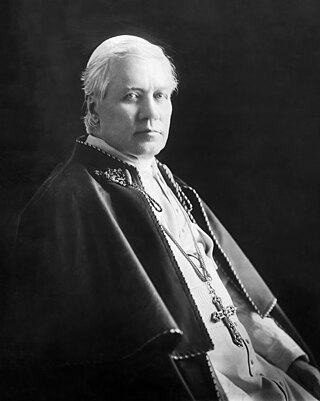
Pope Pius X was head of the Catholic Church from 4 August 1903 to his death in August 1914. Pius X is known for vigorously opposing modernist interpretations of Catholic doctrine, and for promoting liturgical reforms and scholastic theology. He initiated the preparation of the 1917 Code of Canon Law, the first comprehensive and systemic work of its kind. He is venerated as a saint in the Catholic Church. The Society of Saint Pius X, a traditionalist Catholic fraternity, is named after him.

Pope Benedict XV, born Giacomo Paolo Giovanni Battista della Chiesa, was head of the Catholic Church from 1914 until his death in January 1922. His pontificate was largely overshadowed by World War I and its political, social, and humanitarian consequences in Europe.
Papabile is an unofficial Italian term first coined by Vaticanologists and now used internationally in many languages to describe a Catholic man, in practice always a cardinal, who is thought a likely or possible candidate to be elected pope.

Mariano Rampolla del Tindaro was an Italian Cardinal in the Roman Catholic Church, and the last man to have his candidacy for papal election vetoed through jus exclusivae by a Catholic monarch.

A papal conclave is a gathering of the College of Cardinals convened to elect a bishop of Rome, also known as the pope. Catholics consider the pope to be the apostolic successor of Saint Peter and the earthly head of the Catholic Church.

A papal conclave was held on 18 and 19 April 2005 to elect a successor to John Paul II, who had died on 2 April 2005. Upon the pope's death, the cardinals of the Catholic Church who were in Rome met and set a date for the beginning of the conclave. Of the 117 eligible members of the College of Cardinals, those younger than 80 years of age at the time of the death of Pope John Paul II, all but two attended. After several days of private meetings attended by both cardinal electors and non-voting cardinals, the conclave began on 18 April 2005. It ended the following day after four ballots with the election of Cardinal Joseph Ratzinger, Dean of the College of Cardinals and Prefect of the Congregation for the Doctrine of the Faith. After accepting his election, he took the name Benedict XVI.

The papal conclave held from 31 July to 4 August 1903 saw the election of Cardinal Giuseppe Melchiorre Sarto to become pope in succession to Leo XIII, who had died on 20 July after a 25-year-long pontificate. Some 62 cardinals participated in the balloting. Emperor Franz Joseph of Austria asserted the right claimed by certain Catholic rulers to veto a candidate for the papacy, blocking the election of the leading candidate, Cardinal Secretary of State Mariano Rampolla. Sarto was elected on the seventh ballot and took the name Pius X.

In the papal conclave held from 14 to 16 June 1846, Giovanni Maria Mastai Ferretti, Bishop of Imola, was elected on the fourth ballot to succeed the recently deceased Gregory XVI as pope. He took the name Pius IX. Of the 62 members of the College of Cardinals, 52 assembled in the Quirinal Palace, one of the papal palaces in Rome and the seat of two earlier 19th century conclaves. The conclave was the last to elect a ruler of the Papal States, the extensive lands around Rome and Northern Italy which the Catholic Church governed until 1870.

The papal conclave held from 2 to 6 February 1922 saw Cardinal Achille Ratti elected to succeed Benedict XV, who had died on 22 January 1922. It took fourteen ballots for the 53 of the 60 cardinals assembled in the Sistine Chapel to elect a new pope. Ratti took the name Pius XI and immediately revived the traditional public blessing from the balcony, Urbi et Orbi, which his predecessors had eschewed since the loss of Rome to the Italian state in 1870.
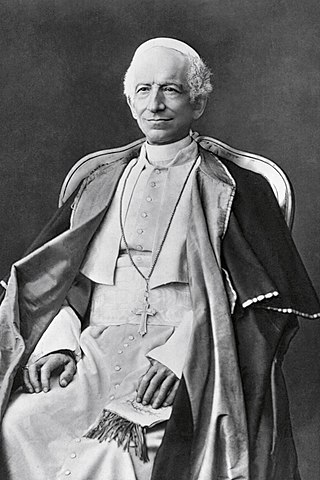
The papal conclave held from 18 to 20 February 1878 saw the election of Vincenzo Pecci, who took the name Leo XIII as pope. Held after the death of Pius IX, who had had the longest pontificate since Saint Peter, it was the first election of a pope who would not rule the Papal States. It was the first to meet in the Apostolic Palace in the Vatican because the venue used earlier in the 19th century, the Quirinal Palace, was now the palace of the king of Italy, Umberto I.

Rafael Merry del Val y Zulueta, was a Spanish Catholic bishop, Vatican official, and cardinal.
Domenico Serafini, O.S.B. Subl. was an Italian Cardinal of the Roman Catholic Church who served in various pastoral, diplomatic, and curial posts, and was elevated to the cardinalate in 1914.
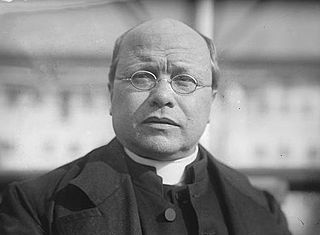
Tommaso Pio Boggiani O.P. was an Italian prelate of the Catholic Church who had a varied career that included a stint as the Apostolic Delegate to Mexico, service as bishop of Adria and archbishop of Genoa, and senior assignments in the Roman Curia. He was a member of the Dominicans and was made a cardinal in 1916.

The 1492 papal conclave was convened after the death of Pope Innocent VIII. It was the first papal conclave to be held in the Sistine Chapel.
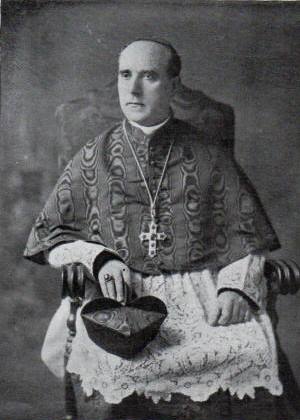
Giovanni Tacci Porcelli known as Giovanni Tacci was an Italian prelate of the Catholic Church who was Bishop of Città della Pieve for twenty years, then a papal ambassador, and finally secretary of the Congregation for the Oriental Churches from 1922 to 1927. He was made a cardinal in 1921.

The 53 cardinal electors in the 1922 papal conclave are listed by region, and within each alphabetically by country. Seven out of the sixty electors did not participate, three for reasons of health: José María Martín de Herrera y de la Iglesia, Giuseppe Antonio Ermenegildo Prisco, and Lev Skrbenský z Hříště. Joaquim Arcoverde de Albuquerque Cavalcanti of São Sebastião do Rio de Janeiro knew he could not reach Rome in time for the conclave and did not attempt the journey. The other three non-European cardinals–William Henry O'Connell of Boston, Denis Dougherty of Philadelphia, and Louis-Nazaire Bégin of Québec City–did not arrive in time to participate in the conclave. Within a month of his election, Pope Pius XI lengthened the waiting period before the start of a papal conclave to allow cardinals from distant places to participate in the balloting.

Of the 65 cardinals eligible to participate, 57 served as cardinal electors in the 1914 papal conclave. Arranged by region and within each alphabetically. Eight did not participate in the conclave. William Henry O'Connell and James Gibbons arrived too late from the United States, as did Louis-Nazaire Bégin from Quebec. Sebastiano Martinelli, Franziskus von Sales Bauer, Kolos Ferenc Vaszary, Giuseppe Antonio Ermenegildo Prisco, and François-Virgile Dubillard were too ill or too frail.

Bartolomeo Bacilieri was an Italian Cardinal of the Roman Catholic Church. He served as Bishop of Verona from 1900 until his death, and was elevated to the cardinalate in 1901.

Ottavio Cagiano de Azevedo was an Italian Cardinal of the Roman Catholic Church. He served as Prefect of the Sacred Congregation for Religious from 1913 to 1915, and was elevated to the cardinalate in 1905.
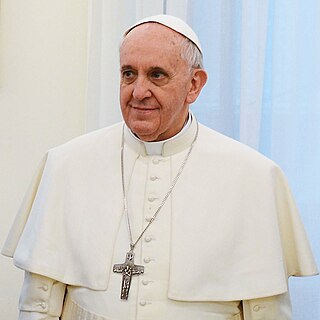
A conclave was convened on 12 March 2013 to elect a pope to succeed Benedict XVI, who had resigned on 28 February. 115 participating cardinal-electors gathered. On the fifth ballot, the conclave elected Cardinal Jorge Mario Bergoglio, SJ, Archbishop of Buenos Aires. He took the pontifical name Francis.



















